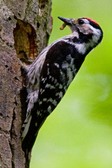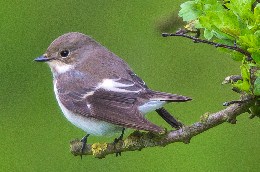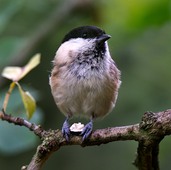

Biodiversity
Action
Plan
Woodland Birds. The drumming of the woodpecker, the flycatcher darting from a branch to catch its insect prey, the calls and songs of birds in spring: Woodland, particularly broadleaved, shelters a range of birds feeding on the insects and other invertebrates they find there, as well as seeds and berries during the winter months.
Local Priority
Woodland Bird Species
(included in woodland indicator)
S41, Red Listed
Hawfinch, S41, Red
Greenfinch, Red (2021)
Redpoll (lesser), S41, Red
Lesser spotted
Woodpecker, S41 Red
Spotted flycatcher, S41, Red
Tree pipit, S41, Red
Willow Tit, S41, Red
Wood Warbler, S41, Red
S41, Amber Listed
Bullfinch, S41, Amber
Dunnock, S41, Amber
Song Thrush, S41, Amber
Red listed (not S41)
Mistle Thrush
Pied Flycatcher
Woodcock
- - - - - - - - - - - - - - - -
Other birds:included in Woodland Bird Indicator
Specialist woodland birds
Blackcap,
Chiffchaff
Coal Tit
Garden Warbler
Goldcrest,
Great Spotted Woodpecker,
Green Woodpecker,
Jay
Nuthatch
Redstart,
Siskin
Sparrowhawk,
Treecreeper
Generalist birds in woodlands
Blue Tit
Blackbird
Chaffinch
Great Tit
Lesser Whitethroat
Long-tailed Tit
Robin
Tawny Owl
Wren
In common with the rest of the country, birds heavily reliant on woodland for food, breeding and roosting, such as Lesser Spotted Woodpecker, Spotted Flycatcher and Willow Tit, have severely declined in numbers, as have Lesser Redpoll and Woodcock.
Very small numbers of the migratory Tree Pipit and Wood Warbler still breed in the upland fringe woodlands and Pied and Spotted Flycatcher are becoming increasingly scarce. Hawfinch may no longer breed here.
More adaptable species such as Long-tailed Tit, Blackcap and Nuthatch, able to use a wider range of habitats, including wooded farmland and gardens, have increased in numbers. Great Spotted Woodpecker occurs in all types of woodlands and is capable of extracting seeds from pine cones, insect larvae from inside trees, and eggs and chicks of other birds from their nests - as well as peanuts from feeders. No surprise it has increased in numbers.
Deciduous woodland, conifer plantations, wet woodland and scrub can support important populations of seed-eating and invertebrate-eating birds. Woodland birds need a safe nesting habitat with ample food for their young. Breeding success is directly related to lack of predation and availability of food.
Changes in woodland habitat are the most likely driver of woodland bird declines - increases in woodland age, reduction in active management, and changes in woodland structure and understorey vegetation. These result in turn in the loss of breeding and year round foraging habitats, with less seed and invertebrate food, meaning that many woodland birds have fewer places to nest, raise fewer young, and are less able to survive the winter.
In the BAP we have highlighted 14 local priority bird species that breed in woodland in Barnsley for which habitats should be maintained and enhanced.
Although woodland birds benefit from good generic habitat management, some woodland bird species benefit from particular habitat features. Information on these is given in the section on individual priority woodland bird species - see links on the right.
Woodland birds


